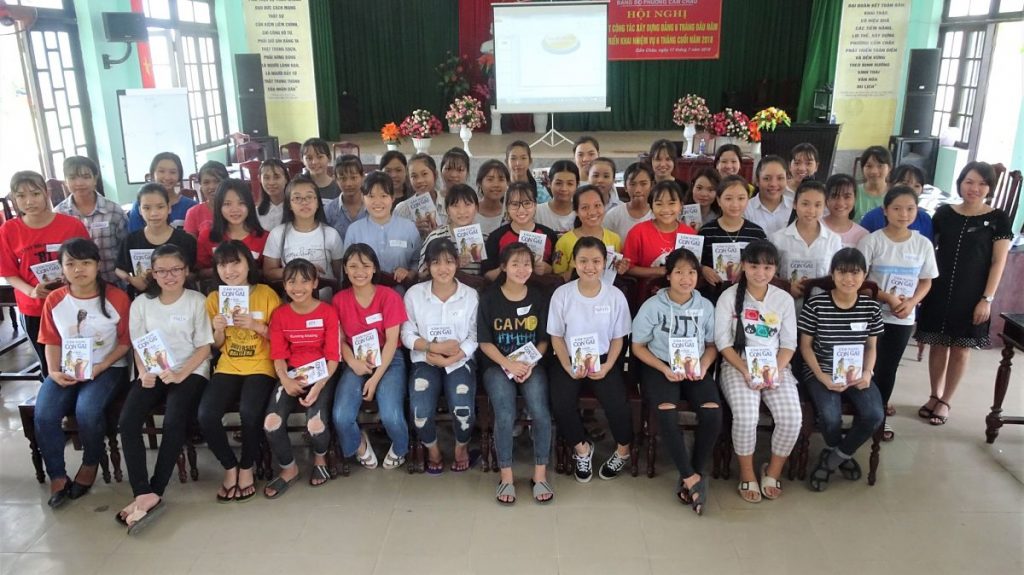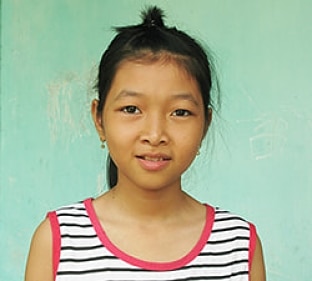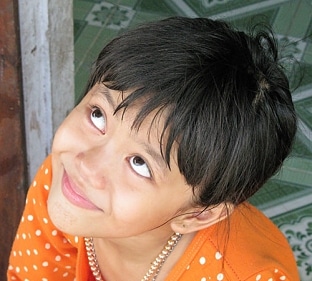“He changed when he found out I was having a girl. We don’t live together anymore. He doesn’t want to see her, or me, and neither do his family. Because she is a girl and I’m the one who had her.”
Ai and her daughter Xuan are from Hoi An. Thanks to the tourism boom the town has experienced over the last decade or so, Hoi An has become one of the more affluent parts of Vietnam. In the poorer, more remote regions of rural Central Vietnam, the attitudes towards girls are far worse. There is, as Ai’s story indicates, a disinclination to have daughters. There is even less of an inclination to educate them. There are less opportunities outside the home or off of the fields and sidewalks available for girls and women; consequently, they also face significantly greater risks of becoming victims of human trafficking, and ending up enslaved in sweatshops, brothels, mail-order marriages, or the black market organ trade. And so the cycle of poverty, discrimination, and exploitation continues.
One organization working to break this cycle is CEF, the Children’s Education Foundation – Vietnam, a not-for-profit operating in Vietnam and registered in Australia and New York. They aim to do so by “helping girls from impoverished or marginalized communities complete school or receive further education or training” with the ultimate goal of “helping not just the young women, but also succeeding generations and their communities to have the possibility of a better life with more choice,” or, indeed, any level of choice, by rendering them much less susceptible to trafficking and much less dependent on, or restricted by, the whims of a culture that views them as unworthy of schooling and basic literacy, among a host of other things.
Linda’s Story
Formally registered in Australia in 2003, CEF was founded by Linda Burn, an Australian who began working to raise educational funds for Vietnamese children in 1999. Linda’s husband, Graeme, has been the Australian manager of the organization since the beginning. This work arose spontaneously, as she describes it, having first visited Vietnam not with the intention of starting a charity, but rather of setting up a culinary tour of Vietnamese cuisine for her students. During the tour, Linda found herself “face-to-face” not just with Vietnam’s wealth of culinary delights, however, but also with the abject poverty of three children whose parents had abandoned them and “whose care-giver could not afford to educate them.” Ultimately, they came to an agreement whereby the caregiver would feed and clothe the children, while Linda would raise funds for their education.
In 2001 on a trip back to Vietnam to see the children now sponsored in Ho Chi Minh City, Linda visited the central highlands. The poverty and illness she saw on that trip spurred a three year fundraising effort to create a medical center to provide free medical care and medicine for the families of a rural K’Ho village. The Red Cross run it for CEF and it has seen the health of the families greatly improve and has had the advantage of bringing up school attendance.
As she got to know more Vietnamese families and witness some of the harsher realities of life in Vietnam that tourists may not often see, or want to see, she saw “how hard the women worked, how tired they were, and that most of the financial burden was on their shoulders.” Noticing that many girls from the poor families were at risk of not receiving an education due to the poverty of their parents, and the sons being a priority when it came to education… [she] wanted to see the girls have a chance to have a better life, and felt if some girls could be educated and complete high school, they would have a different future as educated women and could break the poverty cycle of their family.
CEF Today
CEF has since grown, and now provides educational (and, if needed, food, accommodation, and transportation cost) support directly to girls and young women, and, in a limited number of especially challenging cases, boys and young men. CEF’s concentration on education for girls is largely a function of, and grows out of a desire to address, the Taoist- and Confucianist-influenced educational priority rural Vietnamese boys generally receive, and the negative implications that this prioritization has for girls. Although women are often the main breadwinners in rural families, they are also expected to be the primary domestic and familial caregivers, and this, combined with the cultural emphasis on male over female education, leaves many poor females with little or no opportunity for schooling – whether at a primary, secondary, or tertiary level – and a significantly increased vulnerability to traffickers and future poverty. At present, CEF currently sponsors 230 school students and 31 tertiary students, and runs anti-trafficking educational workshops for these students and their staff. CEF has active education programmes in Da Nang and Quang Nam, and sponsorship costs for a single child run, depending on the class level, between about 260 to 385 USD (6 – 8.9 million VND).

A Little Goes a Long Way
It is both saddening and hopeful to read the stories of CEF students. Almost every girl has been either abandoned, orphaned, or left with a single, but typically ill or disabled, parent; most live with aging grandparents or other extended family members who struggle to scrape by, making meagre livings – as little as 10 USD (240,000) per month in many cases – with itinerant work, small-scale manual or agricultural labour, or street hawking. Take Dieu, for example:
“Dieu’s parents drowned. Since then she, and until four years ago her brother and sister, lives with her elderly grandparents who are sweet and caring. Due to their advanced years and fragility, she looks after them more than they look after her. Her sister also received educational support from CEF to complete high school and attend college and lived at home until she married recently and now lives near by. Her brother has been at university and soon completes his degree. Dieu has been sponsored for eight years and is doing well at school.”


“Diem Quynh has a lot of character and is full of energy. Having HIV doesn’t seem to impact her present-day life in any obvious way, except that she has to take her medications at set times and have regular health checks. Both her parents have passed away from HIV. From when she was born she has lived with her grandparents and one cousin. Granny is a farmer and garbage collector who works hard to support the family. Quynh loves school mainly for the friendships and art.”
Going to school, of course, by no means guarantees an immediate high-paying path out of poverty. Even if educated literate women are, in terms of sheer ability, qualified for a much wider range of better-paying jobs than uneducated illiterate ones, so long as “men continue to play a dominant role in making decisions on access to and use of resources and services,” and “traditional, gender-biased labour division arrangements remain common” as a result, it may be that Quynh, despite being educated, follows in her grandmother’s footsteps, career-wise. But this wouldn’t make CEF’s efforts a failure. How else is the male monopoly on decision-making to end other than with female literacy? Indeed, a priority-ranking study among women in the rural Soc Chua village “indicated the following implications and consequences of illiteracy,” which extend beyond the difficulty of finding a good job, and which CEF helps girls overcome:
- Not good at calculating: “Being illiterate, I don’t even know how much they pay for my labour.”
- Dropping out of school to get married prematurely: “Having dropped out of school I ended up getting married.”
- Feeling shy and unconfident about inter-personal communication: “I am afraid of making mistakes. Would rather keep quiet.”
- Difficult to teach children: “If you are literate you can read and teach your children. Otherwise how can you teach them? Nowadays children have to learn difficult things.”
- Difficult access to information: “If you are literate you can quickly understand. Otherwise you only get the bits and pieces. When you go to the hospital you would not know how to get to the right department. When you watch TV at home you would only see the images without understanding a word of what is spoken.” (Oxfam)
Certainly, the hope is that girls like Diem and Quynh – or, failing that, their daughters, should they end up having any – will be able to find better paying jobs than their mothers and grandmothers have. But addressing points one to five is equally necessary if the cycle of poverty and gender inequality of opportunity is to ever be broken, and that is exactly what CEF is setting out to do. So if you have a few minutes, take a look at the student directory on their website. It shows many, many different unhappy, very difficult family circumstances. But it also shows each girl’s life being indisputably improved by the educational support they are receiving from CEF and its generous donors, and each girl’s family having better chances at a happier future because of her education.
If you would like to learn more about CEF, get involved, or make a donation, more information can be found on their website.
For more charities in and around Hoi An, see our charities page.
i have some vietnemes dong and would like to donat i’am in australia i would need to send donation by mail is there a postal addresse available regards tom kelly
Hi Thomas, you should find everything you need here: http://www.childrenseducationfoundation.org.au/